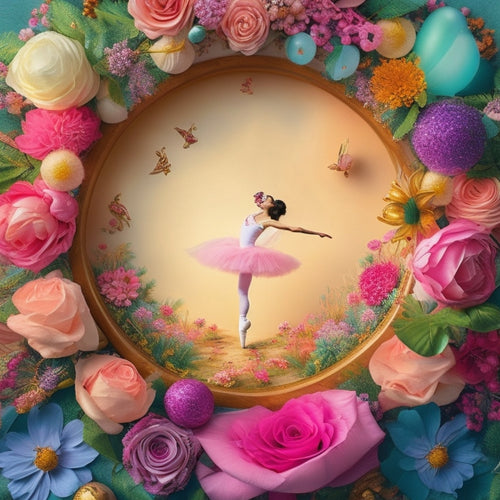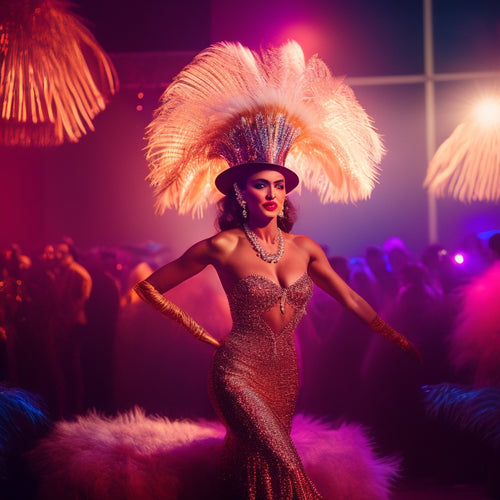
Why Dance Makeup Artists Need Special Effects Tutorials
Share
As a dance makeup artist, you know that a flawless blend of technique and creativity is essential to bringing a performance to life, and mastering special effects techniques is the key to accessing a new level of visual storytelling. You need to elevate your performances visually, creating realistic injury effects, mastering character transformations, and enhancing fantasy creatures' designs. Building confidence through practice and staying ahead of online trends will take your artistry to the next level. By mastering special effects, you'll reveal new creative possibilities, and discover innovative ways to transform your imagination into reality - and that's just the beginning.
Key Takeaways
• Dance makeup artists need special effects tutorials to enhance their visual aspects, collaborating with lighting designers for a greater impact.
• Understanding anatomy, skin texture, and color theory is crucial for creating realistic injury effects, which can be achieved through special effects tutorials.
• Special effects tutorials can help dance makeup artists master character transformations, using color theory for design and manipulating the human form for realistic results.
• Enhancing fantasy creatures' designs requires nuanced textures, intricate details, and fantastical effects, which can be learned through special effects tutorials.
• By learning special effects techniques, dance makeup artists can build confidence and practice, overcoming self-doubt and achieving creative freedom.
Elevating Dance Performances Visually
By incorporating special effects makeup into your dance performances, you can elevate the visual aspect of your show, transporting your audience to new and imaginative worlds. This fusion of dance and makeup artistry can create an immersive experience, drawing the audience into the narrative of your performance.
When integrating special effects makeup into your dance routine, consider the costume design and how the makeup can complement or contrast with the attire. For instance, if your costume features metallic accents, you can use shimmering eyeshadows or metallic lip colors to create a cohesive look.
Lighting also plays an important role in showcasing your special effects makeup. Strategic stage lighting can accentuate the makeup design, highlighting specific features or creating dramatic shadows. By working with your lighting designer, you can make sure that the lighting enhances the visual impact of your makeup, creating an unforgettable visual experience for the audience.
Creating Realistic Injury Effects
As you prepare to create realistic injury effects, you'll need to master the fundamentals of wound construction. This involves building up layers of prosthetic pieces and blending edges seamlessly into the skin.
Next, you'll focus on perfecting blood texture techniques. This includes experimenting with different consistencies and hues to achieve a convincing, freshly wounded look.
Wound Construction Basics
Constructing a realistic wound requires a thorough understanding of anatomy, skin texture, and color theory to create a believable, three-dimensional injury that captivates the audience.
As a dance makeup artist, you'll need to master the basics of wound construction to create convincing injuries that enhance the performance.
To begin, you'll need to understand the anatomy of the skin and how it responds to injury. This knowledge will help you create a realistic wound that looks like it's a part of the performer's skin.
Prosthetic application is an essential aspect of wound construction. You'll need to learn how to apply prosthetic pieces seamlessly, blending them with the performer's skin to create a natural look.
Scar mapping is another vital technique to master. By mapping the scar tissue, you can create a realistic pattern of injury that tells a story.
By combining these techniques with your understanding of color theory, you can create a wound that looks fresh, infected, or in the process of healing.
With practice and patience, you'll be able to create realistic wounds that will leave your audience in awe.
Blood Texture Techniques
Mastering blood texture techniques is crucial for creating realistic injury effects. You'll need to replicate the viscosity, color, and sheen of real blood to convincingly simulate injuries that leave your audience gasping in shock. To achieve this, you'll need to understand blood consistency, which can range from thick and syrupy to thin and watery, depending on the type of injury. For fresh scars, you'll want to create a more liquid consistency to mimic the initial bleeding stage.
When applying blood texture, you'll need to take into account the surface it's being applied to. For example, on skin, you'll want to use a thinner consistency to create a more realistic, dripping effect. On fabric or other materials, you can use a thicker consistency to create a more textured, dried-blood look.
To add an extra layer of realism, experiment with layering different blood textures and colors to create a multi-dimensional effect. By mastering blood texture techniques, you'll be able to create convincing, jaw-dropping injury effects that will leave your audience in awe.
Mastering Character Transformations
As a dance makeup artist, you're about to discover the secrets of character transformations, where artistry meets technical skill.
You'll learn how to merge character design fundamentals with innovative techniques to transform the human form, pushing the boundaries of what's possible.
Character Design Fundamentals
What does it take to bring a character to life, and how do you ensure that every brushstroke and color choice contributes to a cohesive, believable transformation?
As a dance makeup artist, you know that mastering character design fundamentals is essential to creating a convincing character transformation. To achieve this, you'll need to explore the world of Color Theory, understanding how to select a palette that complements your character's personality, tone, and setting.
You'll also need to hone your Anatomy Study skills, learning how to exaggerate or modify facial features to create a character that's both recognizable and unique. By combining these skills, you'll be able to create a visual language that tells a story and transports your audience to a new world.
As you design your character, remember to balance creativity with technical precision, ensuring that every detail, from prosthetics to makeup, contributes to a cohesive, believable whole.
Transforming the Human Form
With a deep understanding of character design fundamentals, you're now ready to push the boundaries of transformation by manipulating the human form to create characters that defy reality.
As a dance makeup artist, you'll learn to transform bodies into creatures, animals, or abstract beings, using body modification techniques to alter the shape, proportion, and texture of the human form. This requires a deep understanding of form manipulation, where you'll learn to elongate, shrink, or distort body parts to create an otherworldly appearance.
To master character transformations, you'll need to experiment with various materials and techniques, such as prosthetics, molding, and casting. You'll learn to create realistic skin textures, veins, and muscles, and understand how to blend colors and shades to achieve a seamless shift between the modified body parts and the surrounding skin.
Enhancing Fantasy Creatures Designs
You'll often find that adding subtle, nuanced textures to your fantasy creature designs can elevate them from mere monsters to mythical beings with depth and character. By incorporating intricate details, you can create a sense of history and lore behind your Mythic Beasts.
For instance, adding Fantastical Scales that shimmer and glimmer can give your creature an otherworldly aura. To achieve this, experiment with layering translucent paints or using iridescent powders to capture the light.
When designing your creature's skin, consider the texture and pattern of their scales – are they smooth and glossy, or rough and weathered? By answering these questions, you can craft a creature that's both visually striking and rich in narrative potential.
As you refine your skills, you'll be able to conjure entire worlds with your makeup artistry, transporting your audience to domains both magical and mysterious.
Building Confidence With Practice
How can consistent, deliberate practice help you overcome self-doubt and cultivate the confidence to bring your most imaginative fantasy creatures to life? The answer lies in building mental preparation through repetition and mastery of special effects techniques.
As you commit to regular practice, you'll develop a sense of creative freedom, unshackling your imagination and allowing your most fantastical designs to take shape.
With each successful execution, your confidence grows, and self-doubt slowly fades away. You'll find yourself tackling more complex designs, experimenting with new materials, and pushing the boundaries of what's possible.
This deliberate practice not only refines your technical skills but also trains your mind to think creatively, solving problems and adapting to unexpected challenges.
As your confidence grows, so does your artistic voice, allowing you to bring your unique vision to the world of dance makeup artistry. With consistent practice, you'll release your full creative potential, transforming your imagination into breathtaking reality.
Staying Ahead of Trends Online
By regularly scouring social media, blogs, and online forums, you're able to tap into the pulse of the dance makeup artistry community, staying informed about the latest trends, techniques, and products that are redefining the industry.
This constant stream of information allows you to adapt and evolve as a makeup artist, ensuring your skills remain relevant in an ever-changing landscape.
To stay ahead of the curve, it's essential to understand how algorithm updates impact your online presence. By keeping up with these changes, you can refine your social media strategy to maximize visibility and engagement.
Moreover, leveraging social insights can help you identify emerging trends and identify opportunities to innovate and differentiate yourself from others.
Frequently Asked Questions
What Is the Best Way to Clean and Maintain Prosthetic Pieces?
"When handling prosthetic pieces, you'll want to clean them gently with soap and water, then store them in a cool, dry place, like a prosthetic storage case, to prevent damage and adhesive removal issues."
Can I Use Household Items to Create Special Effects?
You can get creative with DIY alternatives and everyday substitutes to achieve special effects, like using corn syrup for blood or flour for a dusty, worn look, but be cautious of durability and hygiene.
How Do I Achieve a Realistic Sweat and Shine Effect?
To achieve a realistic sweat and shine effect, you'll want to perfect the sweat consistency, using a mix of water and glycerin, and control the shine intensity with a subtle layering of highlighting products, blending for a natural glow.
What Are Some Common Mistakes to Avoid in SFX Makeup?
'When creating SFX makeup, you'll want to avoid common mistakes like over-reliance on airbrush pitfalls, such as uneven coverage, and makeup malfunctions, like poorly blended edges, to guarantee a seamless, realistic finish that wows your audience.'
How Long Does It Take to Master a New SFX Technique?
As you begin mastering a new SFX technique, remember that practice and patience are key; it takes around 20-50 attempts to develop muscle memory, and consistent skill building will refine your craft over time.
Related Posts
-

Elevate Your Skills: 3 Digital Dance Makeup Courses
You're one step away from accessing your full potential as a dance makeup artist. Master essential techniques like bl...
-

Ballet Cut File Set: Versatile Designs Available
The Ballet Cut File Set offers a wide-ranging collection of versatile designs available in multiple formats, includin...
-

Unleash Your Inner Showstopper: Tap-lesque Mini Course
This Tap-lesque Mini Course is an all-encompassing program designed to empower beginner to intermediate level tap dan...


